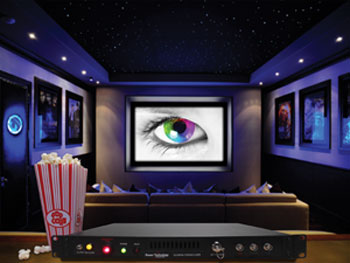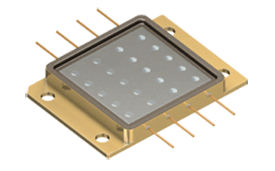Walter Burgess and Kris Hesson, Power Technology Inc.
Laser technology is poised to bring back the magic to 3-D cinema – and bring audiences back to theaters in droves.
Just five short years ago, the world was hypnotized by the release of the first commercially successful 3-D movie, “Avatar.” The film’s global box-office earnings were about $2.8 billion, causing audiences, movie producers and movie theater owners to proclaim the dawn of a new golden age of cinema. The spectacle of the 3-D format was the future, and the future was now – or so the industry believed.
Those who tried to mimic the success of “Avatar” made bad technology choices and delivered hasty postproduction conversions. Audiences quickly developed a bad taste in the mouth for anything 3-D. The “experience” just wasn’t there, and the magical success of “Avatar” faded into legend.
From a high of 1.5 billion tickets sold worldwide in 2002, sales plunged by 300 million tickets to an estimated 1.2 billion tickets in 2014. The industry seemed to be in free fall, scrabbling to find ways to entice audiences back to movie theaters.
One more piece of the puzzle played into declining ticket sales and a slew of 3-D flops: The viewing experience for a 3-D film was almost miserable. Sitting in a dark theater wearing clunky 3-D glasses that feel like sunglasses doesn’t make for the most enjoyable experience. With an average of only 20 percent of light reaching the viewer’s eye, the movie is just too dark to see and appreciate. As a result, in the U.S. and Canada alone, ticket sales in 2013 had declined by over 160 million transactions in comparison with 2004.

Laser illuminated Projection will first be available to commercial and industrial customers. Eventually if may find its way to high-end home theater systems. Photo courtesy of Power Technology.
The darkness of 3-D films results from the limitation of xenon bulbs as projector light sources. The bulbs can produce only a finite amount of light, and that amount (around 3 footlamberts) is not adequate to produce good 3-D brightness levels (approximately 10 footlamberts or more). In 3-D applications, up to 80 percent of light is lost before it reaches the movie watcher’s eyes. Fortunately, the photonics industry is well placed to overcome that problem. Lasers as light sources for cinema projection are the natural evolution of technology to meet the increasing demands of artists, cinema owners and the moviegoing public.
So if we just stick a few lasers in there and point them at the screen, will every-one come running back to buy movie tickets? If only it were that simple. In reality, mountains of challenges must be overcome, but once again, the photonics industry is uniquely positioned to find solutions.
Some of the initial hurdles, surprisingly, were not engineering challenges but instead the outdated regulations. Under current laser safety regulations, laser-illuminated projection (LIP) is misclassified as a point source; in fact, it is an indirect laser light source.
The Laser Illuminated Projector Association has made great progress in getting laser-illuminated projectors classified appropriately. Today’s legacy regulations were intended for rock concert laser shows, not laser-illuminated projection. A laser-illuminated projector has been proved to be no more hazardous than the lamp-based projectors currently used in every movie theater in the world. In mid-2014, the International Electrotechnical Commission updated its IEC 60825-1:2014 laser regulations to correctly classify laser-illuminated projectors the same as lamp-based projectors. The Laser Illuminated Projector Association hopes that U.S. regulations will be updated soon to reflect the true nature and use of the technology.
One of the first technical challenges that must be addressed is matching the brightness of the light source to the size of the movie screen; a light source must be scalable. Not every theater in the world is a 10-m mom-and-popcorn stand. There are 35-m “premium large-format” screens out there, and cinemas have plans for even bigger screens in the near future. Projector and light-source manufacturers have addressed this technical challenge by developing modular designs that allow more lasers to be added as screen size increases.
When you set out to replace a xenon bulb with other light sources, you quickly eliminate all light sources except lasers. When considering high-intensity bulbs, no other bulb can even come close to the intensity of xenon bulbs. LED sources have potential, but you would have to combine the output of many LEDs to achieve the necessary optical power levels for cinema. Unfortunately, such a large number of LED emitters would result in a source size that is incompatible with digital projection technologies. A supercontinuum laser light source contains the appropriate visible wavelengths, but it is quickly ruled out due to high cost and low output power. After eliminating other light source options, the only viable solution remaining is discrete lasers, which offer the highest output with the lowest cost per lumen.
In the visible part of the spectrum, it
is more cost-effective to combine the outputs of multiple small light sources to
achieve high power levels. A single large laser for red, green or blue is not a cost-effective solution. It would take 100 or more optical watts to satisfy the demands of a typical movie screen. Very few visible lasers in this power range can be made cost-effectively.

Laser arrays like Osram’s PLPM4 can provide the blue light in projector applications. Photo courtesy of Osram Semiconductors.
Two viable architectures – loosely categorized as free-space laser arrays and fiber-coupled light delivery – are capable of delivering the required amount of light to the screen. In a free-space laser array, individual laser diodes are mounted onto a cooling plate in a regular grid pattern. The array may contain hundreds of laser diodes, each of which must be meticulously aligned to eliminate the inherent pointing errors found in all laser diodes (±3°). One generic example of a small laser array is the Osram PLPM4 blue laser. It contains 20 blue laser chips and has an overall output power of 50 W.
The second configuration, fiber optic delivery, uses fiber optics to gather laser light from each individual emitter in a highly efficient manner; the light from multiple fiber optics is then combined into a single beam of light.
Laser manufacturers have been combining multiple-pump laser emitters with fiber optics for decades. This is an ideal example of where the photonics industry is well-positioned to address the lighting needs of the cinema industry. These combining techniques originally were developed for diode-pumped solid-state and fiber laser pumping. Many of these well-tested methods and processes can be applied directly to laser-illuminated projection. Power Technology, Necsel and Christie Digital are just a few of the companies currently using fiber optics to combine laser beams successfully.
Each method has its advantages and disadvantages. Although free-space arrays allow a higher percentage of light to reach the screen, the difficulty of calibration makes for a delicate system. Traditional fiber coupling allows for some light loss, but new methods, along with the relatively small size of the emitters as compared with the delivery fiber, permit high coupling efficiency. In fact, Power Technology achieves over 93 percent coupling efficiency. This tiny coupling loss is easily overcome by adding one or two additional laser diodes at a negligible increase in cost.
The free-space configuration has the advantage of not having the cost of fiber optics. In some case studies, the cost of fiber-coupled light delivery is inflated beyond a real-world value. Thanks to the telecom industry, fiber is a commodity material and has little cost impact.
In the unlikely event of a light-source failure, fiber optic delivery also has a special advantage: An average person can easily replace a fiber-delivered light source. It requires only the following three steps:
1. Unplug the fiber optic cable, data cable and power cable;
2. Remove the failed light source and replace the rack with the spare unit;
3. Reconnect the optical, data and power cables.
The entire operation may take 10 minutes. On the other hand, if a free-space laser array fails, a specially trained technician may be required to fly to the projector’s location for service. In a worst-case scenario, a specialized cleanroom may be necessary to replace the laser array, and the projector may have to be shipped back to the manufacturer to prevent its expensive optics from being contaminated. Either option for repairing free-space arrays could translate into significant downtime for the projector
and therefore revenue loss.
The Moody Gardens theater, part of the Moody Gardens Spa and Convention Center on Galveston Island in Texas, is consistently an early adopter of projection technologies; the first 4K 6P laser-illuminated projector in the world was launched there in November 2014. “This [fiber-coupled] system is designed so that if any one of the modules has a problem, it just turns that module off, and it adjusts the light output so it is even in both eyes and we still get to play,” said Brandon Compton, the theater’s director.
No matter which architecture is used, significant numbers of laser diodes and a significant amount of heat must be managed. Red lasers convert electricity to light with an efficiency of 38 percent, while blue and green lasers have a conversion efficiency of approximately 21 percent. Blue and green semiconductor lasers also require an operating voltage of 6 to 8 VDC. This voltage is three times higher than that of a red laser diode. When totaled, the waste heat from all these laser diodes can be hundreds of watts – not a trivial amount to manage. In Power Technology’s light source, air cooling was chosen over water cooling. While water cooling is efficient, the space demands and increased service costs outweigh the benefits. It should be noted that, even with a heat load of hundreds of watts, lasers produce far less heat than the xenon bulb they replace.
One of the bigger challenges for LIP is on-screen speckle. Lasers make an efficient and bright light source, but they are inherently monochromatic devices. Combining red, blue and green lasers to get white light often produces a grainy pattern on the screen. Those effects can and must be mitigated. Multiple companies have developed technologies to mitigate the effects of speckle. In 2012, Power Technology completed a $1.5 million contract for a Tier 1 military supplier. During the project, five unique methods of speckle reduction were examined, tested, engineered and ranked. The best speckle-reduction method was chosen, and a low-speckle military laser was commercialized. The design entered full production, and more than 80 laser systems were made and deployed. The technology has been proved to reduce speckle effectively while being immune to harsh environments. The knowledge gained during this program was instrumental in making a speckle-reduction technology for use with LIP.
Over the past few years, many speckle-reduction methods have been discussed in the media. One early method involved vibrating the movie screen. Vibrating or moving an optical element within the optical path is another successful way to reduce speckle. Lastly, new screen materials have been introduced to help reduce speckle to acceptable levels. Harkness Screens, a manufacturer of movie screens, has specifically designed the Clarus XC 170 screen for the unique characteristics of laser projection and to help reduce the effects of speckle.
Now that the technical challenges of affordably scalable lumen levels, speckle reduction and heat management have
been met, OEM laser companies are
positioned to make LIP ready for the
next installment of “Avatar” in 2016.
The light sources are sure to deliver incredible levels of brightness and detail
on the screen – and help motivate audiences to return to the theater.
Meet the authors
Walter Burgess is vice president for engineering at Power Technology; email: [email protected]. Kris Hesson is the marketing manager at Power Technology; email: [email protected].